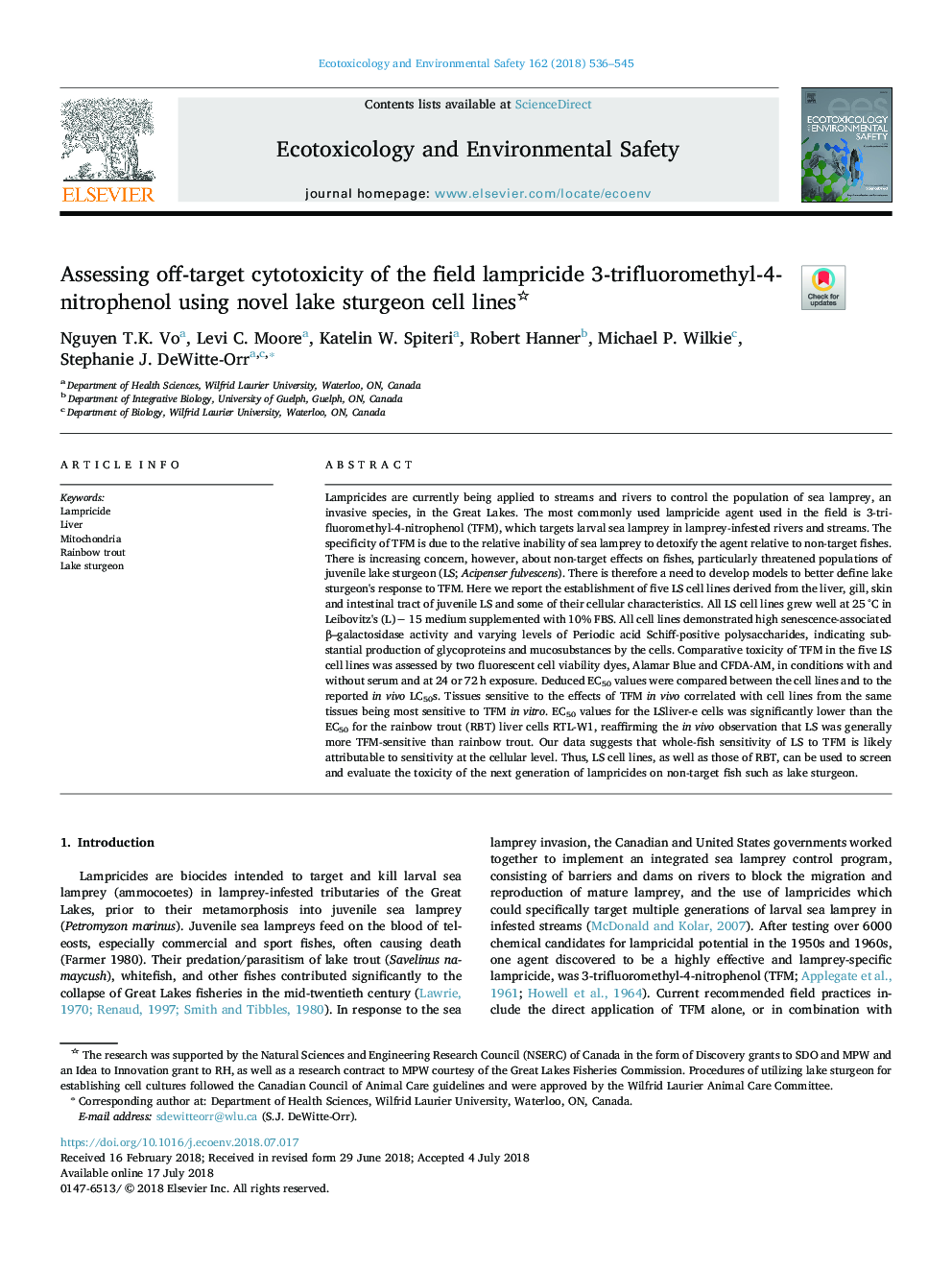| کد مقاله | کد نشریه | سال انتشار | مقاله انگلیسی | نسخه تمام متن |
|---|---|---|---|---|
| 8853298 | 1618902 | 2018 | 10 صفحه PDF | دانلود رایگان |
عنوان انگلیسی مقاله ISI
Assessing off-target cytotoxicity of the field lampricide 3-trifluoromethyl-4-nitrophenol using novel lake sturgeon cell lines
ترجمه فارسی عنوان
ارزیابی سیتوتوکسیتیک غیر هدفدار لام پرسیدهد 3-تری فلوورمتییل-4-نیوتروفنول با استفاده از خطوط سلولی جدید دریاچه
دانلود مقاله + سفارش ترجمه
دانلود مقاله ISI انگلیسی
رایگان برای ایرانیان
کلمات کلیدی
لیموترش کبد، میتوکندریا، ماهی قزل آلای رنگین کمان، دریاچه دریاچه
موضوعات مرتبط
علوم زیستی و بیوفناوری
علوم محیط زیست
شیمی زیست محیطی
چکیده انگلیسی
Lampricides are currently being applied to streams and rivers to control the population of sea lamprey, an invasive species, in the Great Lakes. The most commonly used lampricide agent used in the field is 3-trifluoromethyl-4-nitrophenol (TFM), which targets larval sea lamprey in lamprey-infested rivers and streams. The specificity of TFM is due to the relative inability of sea lamprey to detoxify the agent relative to non-target fishes. There is increasing concern, however, about non-target effects on fishes, particularly threatened populations of juvenile lake sturgeon (LS; Acipenser fulvescens). There is therefore a need to develop models to better define lake sturgeon's response to TFM. Here we report the establishment of five LS cell lines derived from the liver, gill, skin and intestinal tract of juvenile LS and some of their cellular characteristics. All LS cell lines grew well at 25â¯Â°C in Leibovitz's (L)ââ¯15 medium supplemented with 10% FBS. All cell lines demonstrated high senescence-associated β-galactosidase activity and varying levels of Periodic acid Schiff-positive polysaccharides, indicating substantial production of glycoproteins and mucosubstances by the cells. Comparative toxicity of TFM in the five LS cell lines was assessed by two fluorescent cell viability dyes, Alamar Blue and CFDA-AM, in conditions with and without serum and at 24 or 72â¯h exposure. Deduced EC50 values were compared between the cell lines and to the reported in vivo LC50s. Tissues sensitive to the effects of TFM in vivo correlated with cell lines from the same tissues being most sensitive to TFM in vitro. EC50 values for the LSliver-e cells was significantly lower than the EC50 for the rainbow trout (RBT) liver cells RTL-W1, reaffirming the in vivo observation that LS was generally more TFM-sensitive than rainbow trout. Our data suggests that whole-fish sensitivity of LS to TFM is likely attributable to sensitivity at the cellular level. Thus, LS cell lines, as well as those of RBT, can be used to screen and evaluate the toxicity of the next generation of lampricides on non-target fish such as lake sturgeon.
ناشر
Database: Elsevier - ScienceDirect (ساینس دایرکت)
Journal: Ecotoxicology and Environmental Safety - Volume 162, 30 October 2018, Pages 536-545
Journal: Ecotoxicology and Environmental Safety - Volume 162, 30 October 2018, Pages 536-545
نویسندگان
Nguyen T.K. Vo, Levi C. Moore, Katelin W. Spiteri, Robert Hanner, Michael P. Wilkie, Stephanie J. DeWitte-Orr,
